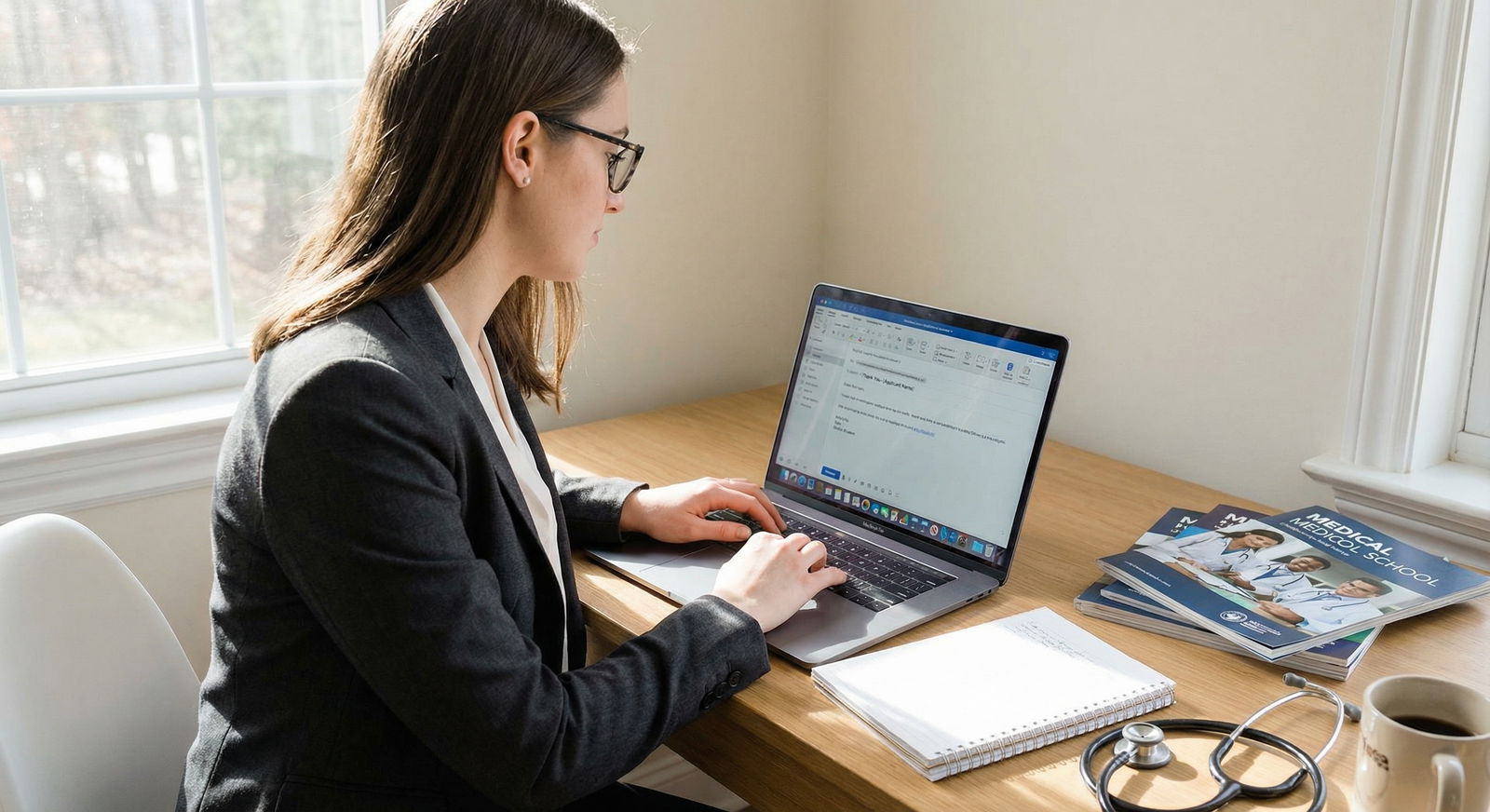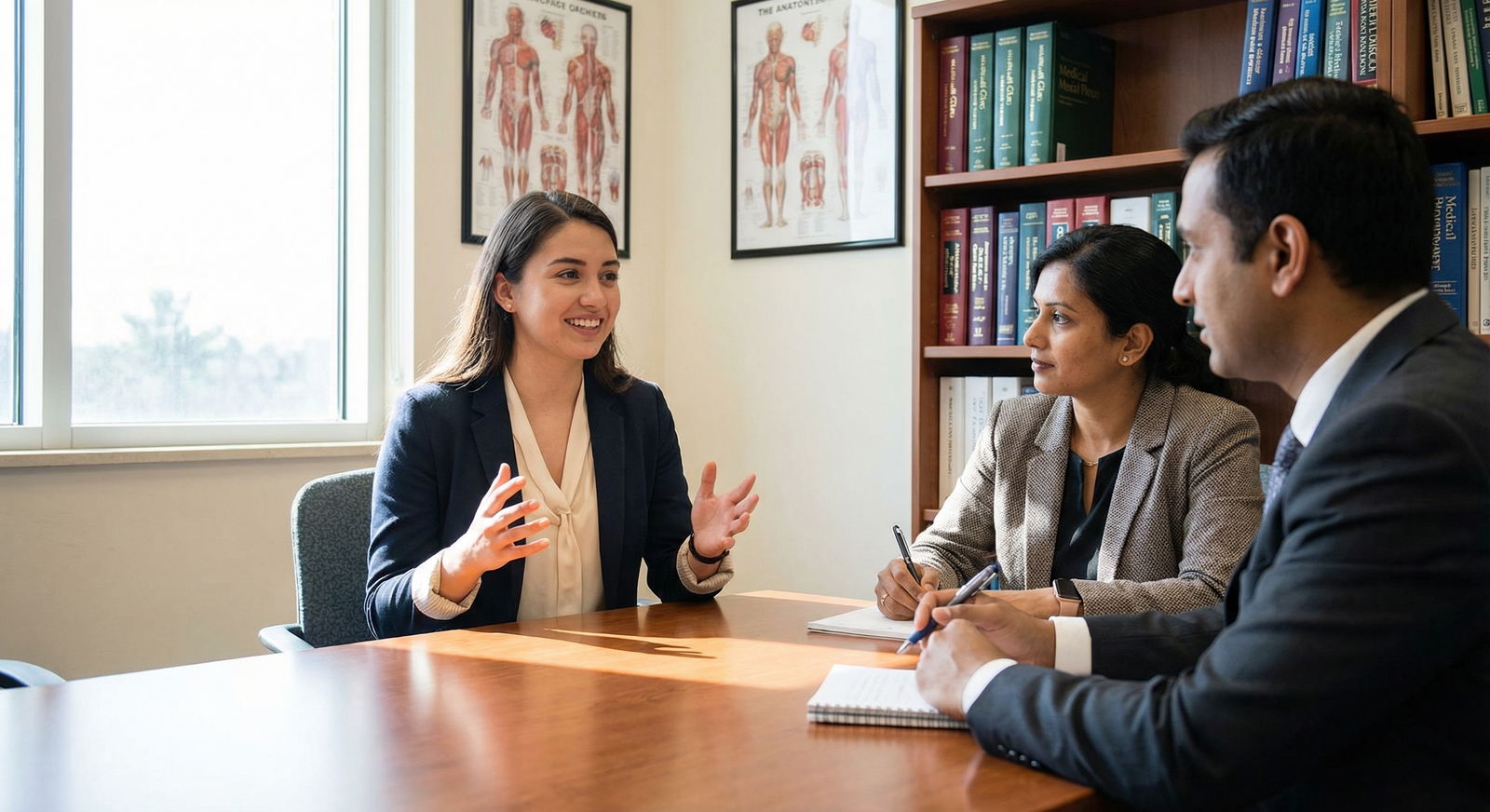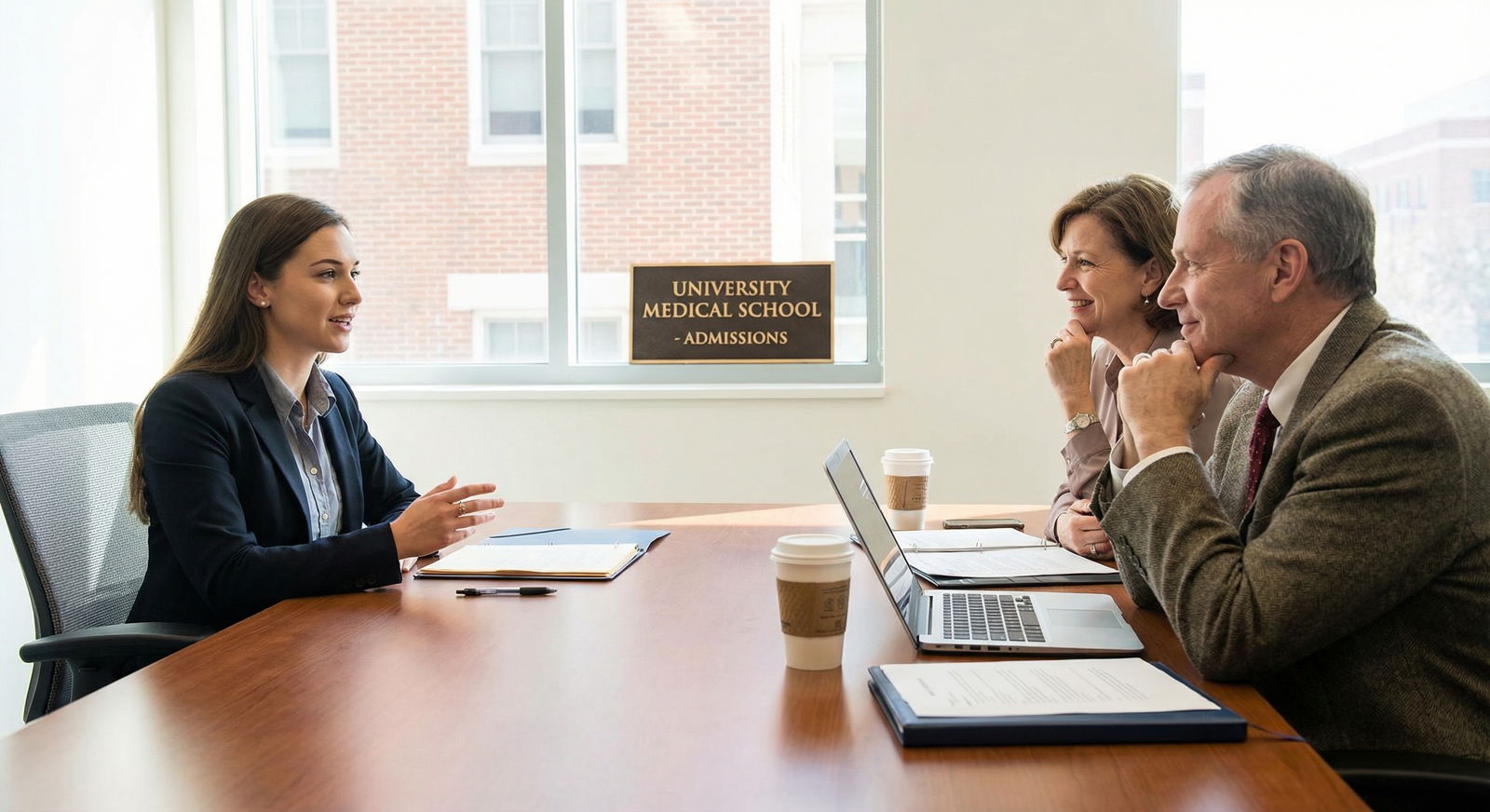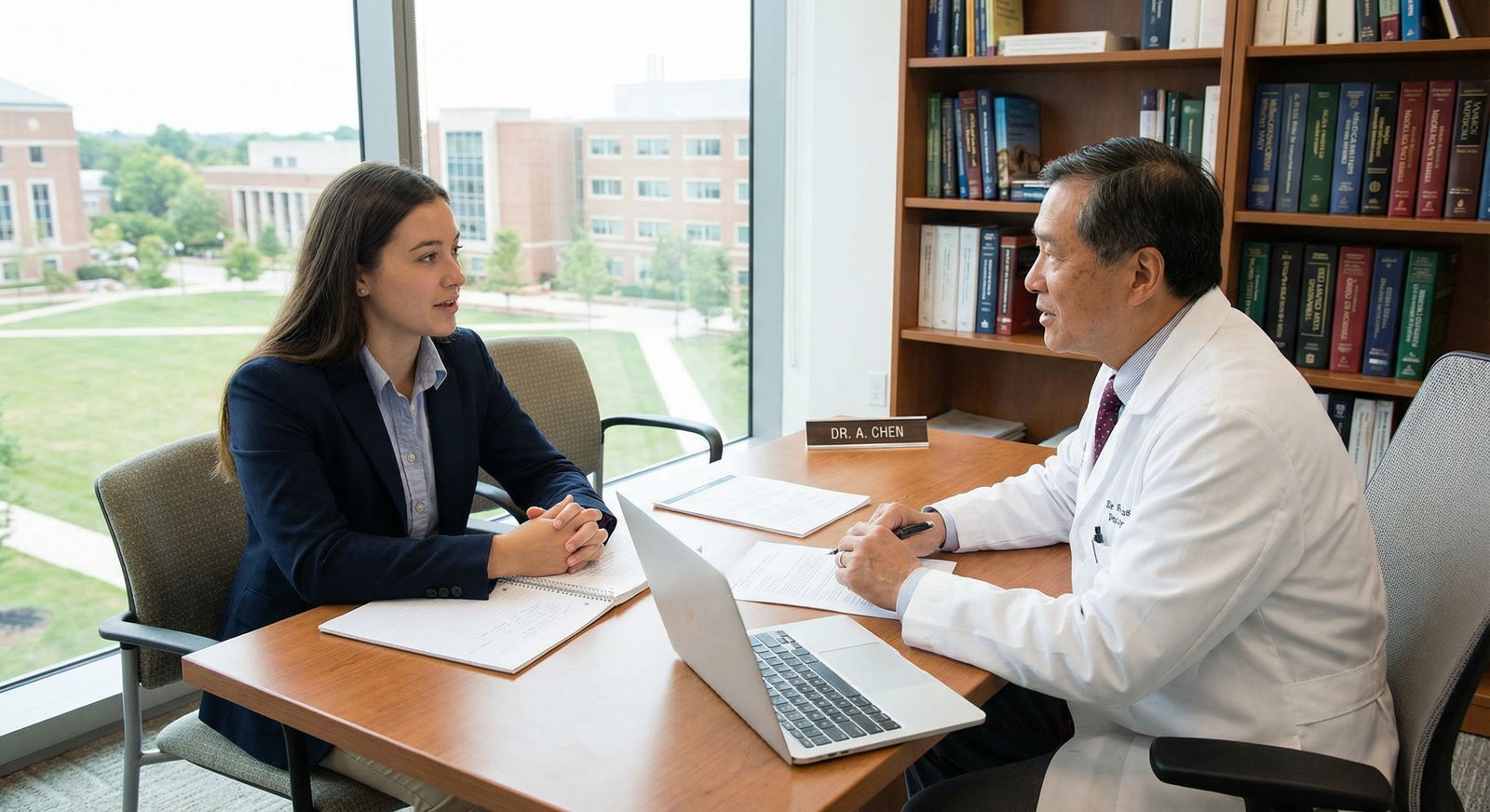The Essential Guide to Perfect Medical School Interview Attire

Why Medical School Interview Attire Matters More Than You Think
Medical school interviews are high-stakes moments. You’ve spent years building your GPA, studying for the MCAT, and crafting a compelling personal statement. On interview day, all of that preparation meets a very human reality: interviewers form impressions of you within seconds—long before you answer your first question.
Your interview attire is not about fashion or impressing people with expensive clothes. It is about professionalism, respect for the process, and signal of readiness for a career in medicine. When you walk into the room, your appearance tells your interviewers:
- You understand professional norms in healthcare
- You respect their time and the opportunity
- You can be trusted to represent their institution in clinical and community settings
When you’re dressed thoughtfully and appropriately, you also help yourself. The right outfit reduces anxiety, boosts confidence, and allows you to focus entirely on your conversation, not your clothing.
This comprehensive guide will walk you through exactly what to wear to a medical school interview, how to adapt based on school culture and weather, and how to make strong first impressions while still reflecting your authentic self.
First Impressions, Professionalism, and the Physician Image
How First Impressions Shape Your Interview
In any professional setting—especially in medicine—first impressions matter. Interviewers are not just evaluating your academic record. They’re asking:
- Would I trust this person with my patients?
- Would I want this person as a colleague?
- Does this applicant understand what it means to be a professional?
Your attire is a visible, immediate cue. While it won’t get you accepted on its own, sloppy or inappropriate clothing can subtly undermine your overall presentation. Clean, well-fitted, professional clothing creates a neutral, positive backdrop so that your character, communication skills, and motivation can stand out.
Professionalism: Dressing Like a Future Physician
Medicine is one of the most trusted professions. Part of that trust is earned by showing up—literally and figuratively—in a professional manner. Interviewers know that how you present yourself now often predicts how you’ll present yourself:
- On clinical rotations
- In front of patients and families
- At conferences, grand rounds, and residency interviews
“Professionalism” in attire doesn’t mean you must conform to a single rigid look. It means your clothing:
- Is clean, neat, and free of wrinkles
- Fits appropriately and does not draw unnecessary attention
- Aligns with business professional norms common in health care
Avoiding Distractions So Your Message Comes Through
Anything that pulls attention away from your words—itchy clothing, noisy jewelry, overly bright colors, or uncomfortable shoes—can subtly disrupt your performance.
When considering your outfit, ask:
- Could anything about this outfit be distracting—to me or to my interviewers?
- Will I still feel comfortable and confident after several hours of sitting, walking, and touring?
If the answer is yes and yes, you’re on the right track.
Understanding the Dress Code: Business Professional vs. Business Casual
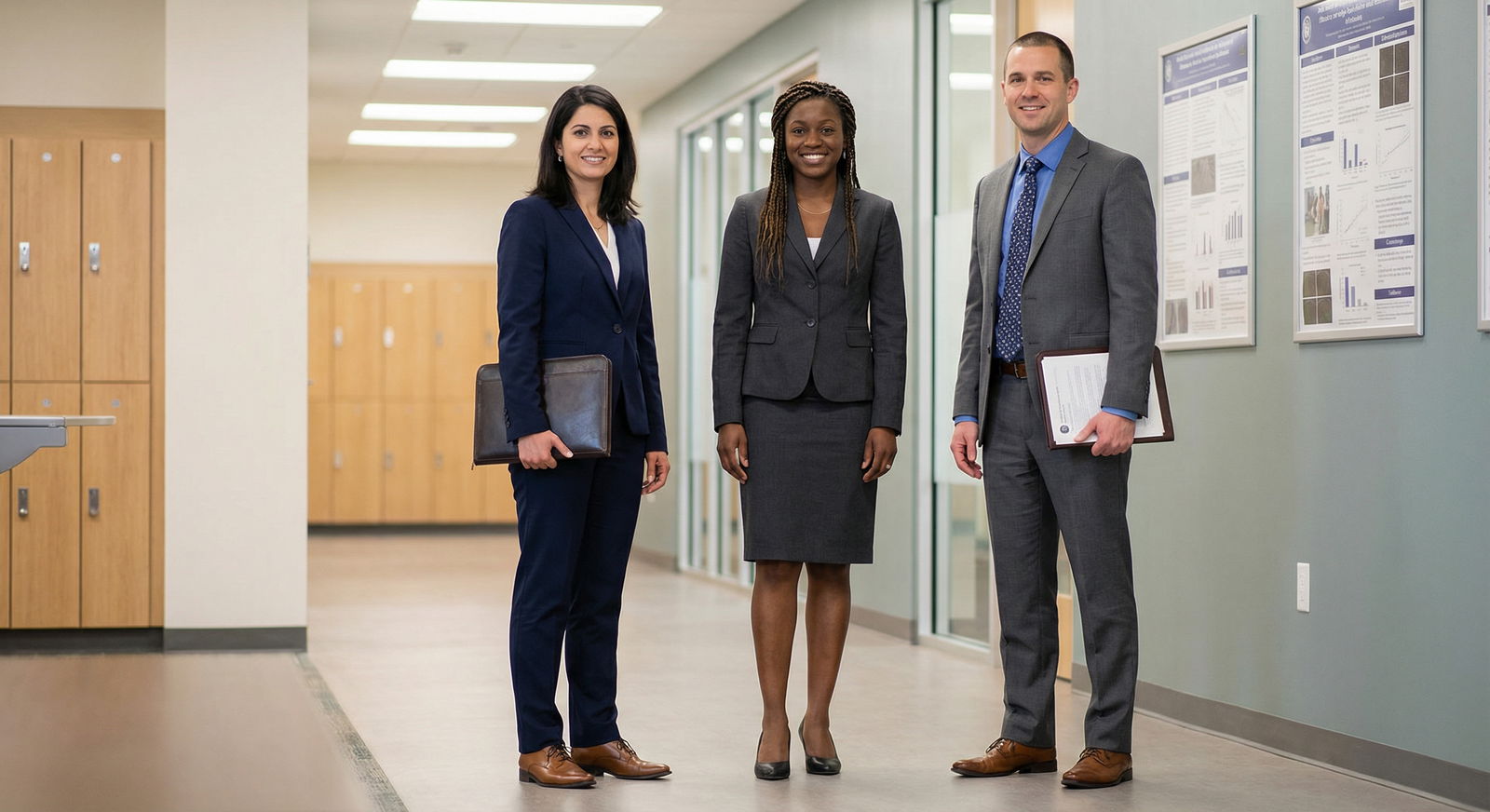
What “Business Professional” Actually Means
Most medical school interviews expect business professional attire. This is the same level of dress you’d see at:
- Residency interviews
- Hospital administrative meetings
- Professional conferences
Core components of business professional:
For applicants who wear traditionally masculine clothing
- Suit: Two-piece suit (jacket + matching pants) in navy, charcoal, or dark gray. Black is acceptable but often more formal and can feel severe in daylight interviews.
- Shirt: Long-sleeve, button-down dress shirt in white, light blue, or another pale neutral.
- Tie (optional but recommended): Simple, conservative pattern or solid color—navy, burgundy, deep green, or subtle stripes. Avoid novelty ties.
- Shoes: Closed-toe leather dress shoes (black or dark brown), clean and polished.
- Socks: Dark, matching the suit or shoes; long enough that skin doesn’t show when seated.
For applicants who wear traditionally feminine clothing
(options can be mixed and matched)
- Suit:
- Pantsuit (matching blazer + slacks)
- Skirt suit (knee-length skirt + blazer)
- Professional sheath dress with a blazer
- Top: Simple blouse, shell, or dress shirt in a solid or subtle pattern. Avoid low necklines or sheer fabrics.
- Skirt/Dress Length: Around the knee when standing; make sure it doesn’t ride up too much when seated.
- Shoes: Closed-toe flats or low heels (1–3 inches), in black, navy, or nude for your skin tone. Comfort > height.
- Legwear: Neutral tights/stockings are optional; choose whatever makes you feel most comfortable and confident.
When Business Casual Might Be Appropriate
Some schools explicitly mention that their day is more relaxed or “business casual.” Even then, as an applicant, it’s safer to err on the slightly more formal side unless they strongly emphasize a casual dress code.
Business casual options:
- Dress slacks or chinos with a button-down shirt or modest blouse
- Optional blazer or cardigan
- For some settings, a professional dress (knee-length, with sleeves or paired with a blazer)
If you’re unsure, aim for business professional. No admissions committee will penalize you for being slightly more polished.
How to Research a School’s Culture
Before deciding what to wear, check:
- Interview invitation email: Some schools specify dress expectations.
- School website or admissions FAQ: Look for “interview day” descriptions.
- Student forums or social media: Search “[School Name] interview attire” to see what others wore and how they felt.
When in doubt, a neutral, professional suit is always appropriate.
Choosing Colors, Fabrics, and Fit: Looking Sharp, Feeling Comfortable
Best Colors for Medical School Interview Attire
Color affects how others perceive you and how you feel in your clothes. For interviews, neutral, conservative colors are your safest foundation.
Strong core colors (for suits and main pieces)
- Navy: Professional, approachable, and versatile
- Charcoal Gray: Serious, polished, and slightly softer than black
- Medium/Dark Gray: Modern and professional
Black can work for suits or dresses, but it can feel very formal and unforgiving in bright lighting. If you choose black, balance it with a softer shirt color like light blue or off-white.
Shirt and blouse colors
- White
- Light blue
- Pale gray
- Soft pastel (light lavender, very soft pink, light teal)—best used subtly and not too bright
Accent Colors: Expressing Personality Without Overdoing It
You don’t have to erase your personality to look professional. Subtle accent colors are a great way to add individuality:
- Ties: Burgundy, forest green, navy with a small pattern
- Blouses or shells: Muted pastel or jewel tones under a dark blazer
- Accessories: A simple colored scarf, conservative earrings, or a watch band
Avoid neon or extremely bright colors that draw more attention to your clothes than your conversation.
Prioritizing Fit: Tailoring for Professionalism
Regardless of brand or cost, fit is what makes an outfit look expensive and intentional. Common fit tips:
Jacket/Blazer:
- Shoulder seams should align with your shoulders, not droop or pinch
- You should be able to button it comfortably without pulling
- Sleeves should hit at the wrist bone, with a bit of shirt cuff visible
Pants:
- Waist should sit comfortably without needing a belt to hold them up
- Hem should lightly touch the tops of your shoes (no bunching, no “high waters”)
Skirts/Dresses:
- Should not ride up excessively when you sit
- Should allow for natural movement when walking and climbing stairs
If possible, visit a tailor for inexpensive adjustments. Small tweaks (hemming pants, taking in a waist, shortening sleeves) can transform budget-friendly pieces into professional-looking attire.
Fabric Choices and Weather Considerations
Medical school interviews happen year-round, in all climates. Your fabric choice can determine how comfortable you feel:
Warmer climates or summer interviews:
- Lightweight wool blends, cotton-blend suits, or breathable synthetics
- Moisture-wicking undershirts to reduce sweat
- Carry your blazer until you enter the building if you’re walking outside
Colder climates or winter interviews:
- Wool or wool-blend suits
- Layers (undershirt, dress shirt, blazer, and a warm, neutral coat)
- Neutral scarf and gloves that match your overall look
Choose fabrics that resist wrinkling and feel comfortable for several hours of sitting and walking.
Footwear, Accessories, and Grooming: The Details That Complete Your Look
Shoes: Professional, Polished, and Walkable
Interview days often include campus tours, walking between buildings, and standing for conversations. Your shoes must be:
- Closed-toe and conservative
- Clean and polished
- Comfortable enough for several hours
Good options:
- Black or dark brown oxfords, derbies, or loafers
- Simple flats in black, navy, or nude
- Low-heeled pumps (block heels are more stable than stilettos)
Avoid:
- Sandals, open-toe shoes, or sneakers
- Very high heels that affect your gait or comfort
- Extremely worn-out shoes or casual boots
If you buy new shoes for the interview, break them in beforehand by wearing them around your home or on short outings.
Accessories: Minimal, Intentional, Non-Distracting
Think of accessories as quiet support, not the star of the show.
Acceptable, low-key accessories:
- Simple watch
- Small stud or modest hoop earrings
- Delicate necklace or bracelet
- Conservative belt matching your shoes
- Professional portfolio or padfolio for your documents
Best to avoid:
- Large statement jewelry
- Noisy bracelets or bangles
- Flashy branded items meant to show off labels
- Overstuffed backpacks with bright patterns
Grooming and Hygiene: Presenting a Polished Professional Image
Grooming is a core part of professionalism and first impressions:
Hair:
- Clean, neat, and pulled away from your face if it tends to fall forward
- Natural styles are completely appropriate; just aim for tidy and intentional
- If you color your hair, make sure it looks maintained
Facial Hair:
- Clean-shaven or neatly trimmed
- Make sure lines are sharp and intentional, not patchy or unkempt
Nails:
- Clean and trimmed
- If polished, keep colors neutral or muted
Fragrance:
- Very light or none at all—some people have sensitivities or allergies
The goal is to appear well cared-for and intentional, not overly styled.
Makeup and Presentation Choices
Makeup is optional and entirely personal. If you choose to wear it, aim for:
- Natural or “your-skin-but-better” tones
- Avoid heavy glitter or dramatic colors
- Focus on looking awake and polished, not ready for a photoshoot
Whatever your gender expression or cultural background, the key is: Would this look appropriate in a hospital or clinic?
Building Confidence: Practicing in Your Outfit and Planning Your Day
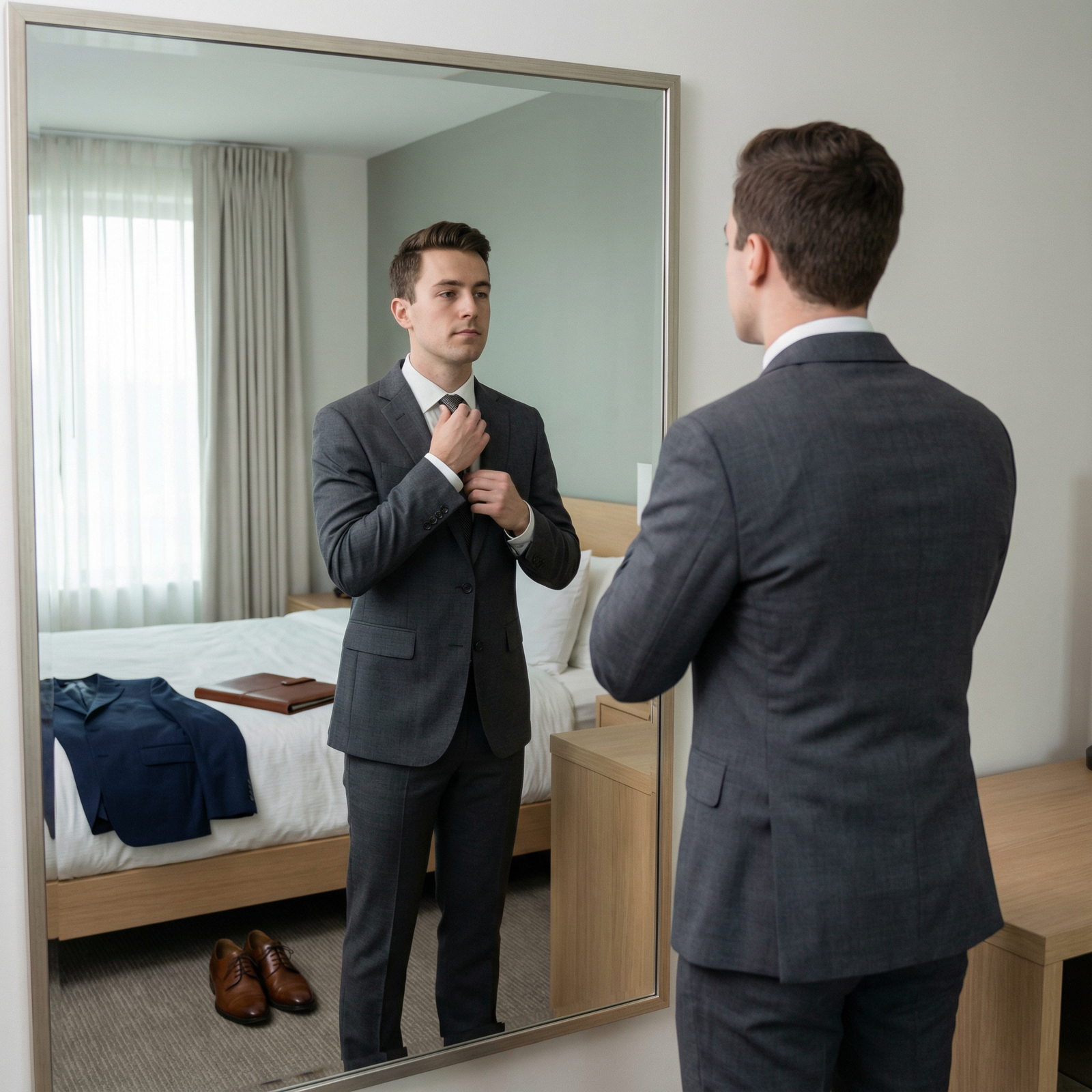
The Night Before: Dress Rehearsal and Final Check
Reduce interview-day stress by treating your attire like part of your preparation:
Try on the full outfit:
- Sit, stand, walk, and raise your arms
- Check that nothing pulls, gaps, or rides up awkwardly
Inspect everything:
- Are there loose threads, missing buttons, or wrinkles?
- Are your shoes clean and polished?
Prepare backups:
- Extra pair of socks or stockings
- Small stain-removal wipe or pen
- Lint roller
Pack your bag or portfolio:
- Interview invitation/itinerary (printed or easily accessible)
- Notepad and pen
- ID, wallet, keys
- Breath mints (not gum)
Morning of the Interview: Calm, Composed, and On Time
On interview day:
- Put on your outfit with enough time to fix any issues
- Do a quick mirror check—front, sides, and back
- Eat a light, non-messy meal
- Bring a jacket or coat appropriate for the weather
Plan to arrive early. Rushing leads to sweating, wrinkles, and heightened anxiety—all of which wear on your confidence.
Confidence Comes from Preparation, Not Price Tags
You do not need designer brands or expensive custom suits. Many applicants successfully build their interview attire from:
- Affordable retailers’ business lines
- Outlet stores
- Secondhand or consignment shops, with simple alterations
What matters far more than cost is that your outfit is:
- Clean
- Well-fitted
- Professionally styled
You’re not being evaluated on how much you spent, but whether you look and act like someone ready to join the profession of medicine.
Frequently Asked Questions About Medical School Interview Attire
1. What should I wear to a medical school interview if I’ve never owned a suit?
Start with a simple, neutral suit in navy or charcoal. You can often find reasonably priced options at department stores, outlet shops, or online retailers. Pair it with:
- A white or light-colored dress shirt or blouse
- Closed-toe professional shoes
- Minimal accessories
Try on multiple sizes and consider inexpensive tailoring to improve the fit. If a full suit is absolutely not feasible, pair dress slacks or a knee-length skirt with a blazer in a coordinating color for a similar professional effect.
2. Can I wear colorful attire, patterns, or cultural clothing to my medical school interview?
Yes—with intention and moderation.
- Color: Subtle colors (burgundy, forest green, muted jewel tones, soft pastels) are perfectly fine for shirts, blouses, ties, or scarves. Keep your main pieces (suit, pants, skirt) in neutral colors.
- Patterns: Thin stripes, small checks, or subtle prints are acceptable as long as they aren’t visually overwhelming.
- Cultural clothing: If wearing cultural or religious attire (e.g., hijab, turban, kente stole, traditional jewelry) is part of your identity, it is appropriate to do so—as long as the overall effect is neat, respectful, and compatible with a professional setting. Many schools welcome visible diversity and authenticity.
3. Is a tie absolutely required for medical school interviews?
If you’re wearing traditionally masculine business professional attire, a tie is strongly recommended, even if not strictly required. It:
- Completes the formal business look
- Signals that you understand professional norms
- Is expected in many conservative environments
If you truly dislike ties, consider a high-quality, collar-button dress shirt and a well-fitting blazer, but understand that many applicants in similar attire will be wearing ties.
4. How important is grooming compared to what I wear?
Grooming and hygiene are just as important as clothing—sometimes more:
- Neatly styled hair and well-groomed facial hair signal attention to detail
- Clean nails and subtle or no fragrance show respect for those around you
- Overall tidiness suggests you’ll bring the same standard to patient care and team interactions
Even an expensive suit cannot compensate for appearing unkempt. Aim for a clean, polished, well-rested look.
5. What should I avoid wearing to a medical school interview?
To maintain professionalism and avoid distractions, steer clear of:
- Jeans, leggings as pants, or very casual trousers
- T-shirts, crop tops, or clothing with large logos or slogans
- Sneakers, sandals, open-toe shoes, or very high heels
- Loud patterns, neon colors, or excessive sparkle
- Excessive perfume or cologne
- Overly large or noisy jewelry
- Clothing that is too tight, too short, or see-through
If you’re unsure about a piece, ask: “Would this look appropriate if I were shadowing in a hospital or clinic?” If not, choose something else.
Dressing for your medical school interview is not about perfection or fashion; it is about aligning your outward presentation with the professionalism and seriousness of your goal. When your attire is thoughtful, comfortable, and appropriate, it fades into the background—in the best way—so that your passion for medicine, your experiences, and your character can take center stage.
Use these guidelines as a framework, not a rigid rulebook. Adapt them to your identity, your budget, and the culture of the schools you’re visiting. With intentional preparation, your interview attire can become one more tool that supports your confidence and strengthens your first impression on the path to becoming a physician.

SmartPick - Residency Selection Made Smarter
Take the guesswork out of residency applications with data-driven precision.
Finding the right residency programs is challenging, but SmartPick makes it effortless. Our AI-driven algorithm analyzes your profile, scores, and preferences to curate the best programs for you. No more wasted applications—get a personalized, optimized list that maximizes your chances of matching. Make every choice count with SmartPick!
* 100% free to try. No credit card or account creation required.



